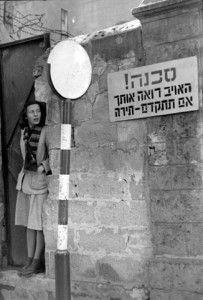The Jerusalem Post, October 2, 2009
Earlier this year, the festive pop and bright flash of fireworks marked the beginning of Tel Aviv’s centennial year. But the celebration was held at Rabin Square – a location that reminds Israelis that, amidst the excitement, there is a sober history to commemorate, as well.
Those dark days of Tel Aviv are the topic of a current exhibition at the Eretz Israel Museum, titled “White City, Black Days.” Comprised primarily of photographs, the exhibition is divided into waves of difficult times that the first Hebrew city has faced from World War I to the present. Though many of these events have long passed, some have left an indelible mark on the city’s urban landscape, and some continue to resonate deep within the Israeli psyche.
World War I broke out in 1914 when Tel Aviv, founded in 1909, was in its infancy. When the Allies used a naval blockade in an attempt to weaken the Ottoman forces, both maritime trade and development of the young city ground to a halt. The Turks hoarded food, leading to widespread shortages; they also deported a large number of Jews from Palestine in late 1914. But eventually, under the leadership of Meir Dizengoff, Tel Aviv emerged stronger, newly affirmed as the Jewish center of Palestine.
Historic documents appear alongside black and white photos. Among other items, visitors can see a list of houses emptied by the deportation, as well as a public announcement of an assembly, held in 1918, in remembrance of the expulsion of Jews from Palestine.
Although Tel Aviv quickly got on its feet after World War I, more trouble lay ahead. In May 1921, the city was rocked by riots. The conflict began between two Jewish factions in the Neveh Shalom neighborhood, but quickly spread to Jaffa as Arab residents expressed their frustrations and disappointment with the British government’s support of the Balfour Declaration. Many Jews fled Jaffa for Tel Aviv and the violence lasted for almost a week, resulting in the death of 48 Arabs and 47 Jews, among them writer Yosef Haim Brenner.
Visitors to “White City, Black Days” will see stark images of injured Jewish residents, as well as pictures of the funeral processions making their way through some familiar urban arteries, including Allenby Street.
Barbed wire – and growing tension – weaves through the photographs that were taken during the last days of the British Mandate. Members of the Jewish resistance sit on the ground surrounded by British soldiers; a tank commands an intersection; a hastily erected barrier prevents citizens from entering a military area.
During the War of Independence, order seems to disappear from the pictures, while chaos reigns. In one photograph, a young woman tucks herself close to a cement block wall, standing next to a sign that reads: “Warning! The enemy sees you. If you move forward, shoot.” The explanatory text that accompanies this portion of the exhibition tells the viewers, however, “life in the parts of Tel Aviv beyond the range of Arab fire, [sic] were [sic] almost routine.”
But war was not yet done with the city, visiting again in 1991, during the First Gulf War. American-led forces, responding to Iraq’s invasion of Kuwait, began Operation Desert Storm; Iraq answered by firing missiles at both Saudi Arabia and Israel. In the Eretz Israel Museum exhibition, a black gas mask is on display – reminding the viewer that Israel feared chemical warfare. A projector shoots images of Tel Aviv – air raid sirens screaming, Scud missiles flashing in the sky – onto a nearby wall.
Occasionally, threats to the Jewish State come from within, as the portion of the exhibition dedicated to the memory of former prime minister Yitzhak Rabin recalls. Rabin was shot on November 4, 1995, at a peace rally in Tel Aviv. Rabin’s assassin, Yigal Amir, was a student at Bar-Ilan University and an extreme right-wing activist. Today, Tel Aviv continues to bear a scar of Rabin’s death, with a square and plaques in his name.
Other such memorials, standing tall where Israelis were laid low, can be found around the city and present-day photographs of these sites are included in the exhibition. The display also includes raw images taken at the time of the terror attacks. Other dark events in Tel Aviv’s history – the riots of 1929 and 1936, the Great Arab Revolt, the air raids that occurred during World War II, floods, fires and the plague – are presented, as well.
But “White City, Black Days” seems to present a Tel Aviv that exists in a vacuum – this makes what would otherwise be a fantastic exhibition a bit troublesome. For example, the explanatory placards accompanying the World War I portion of the display discuss the food shortages caused by the blockade, without mention of the 300,000 deaths in Lebanon and Syria that occurred due to the same blockade. While Jewish residents who fled Jaffa during the War of Independence are referred to as “refugees,” Palestinians who left Jaffa in 1948 simply “abandoned” their homes – offering a disturbingly simple assessment of a complicated situation that continues to reverberate through the State of Israel today.
And if the visitor is expecting to see photographs or documentation of the Palestinian narrative of the city that is today referred to as the Tel Aviv-Yafo Municipality, he will be disappointed.
As this writer viewed the exhibition, she overheard several Jewish-American visitors remarking about the seemingly one-sided nature of both the images and the phrasing of the explanatory text. Those visitors, however, declined to comment for this article.
“White City, Black Days” is on display at the Eretz Israel Museum until March 30, 2010.
 White city, black days
White city, black days